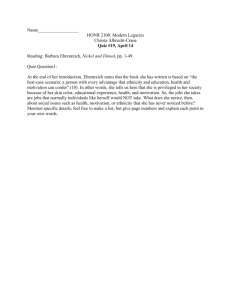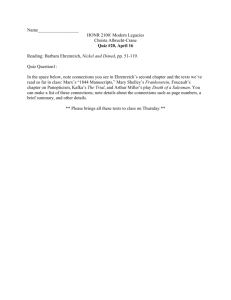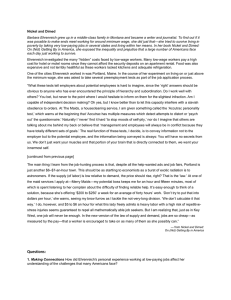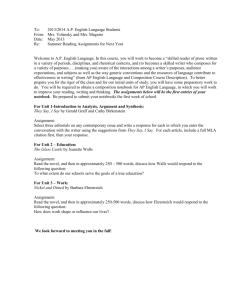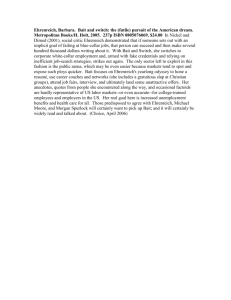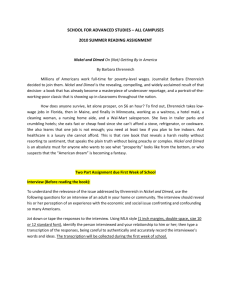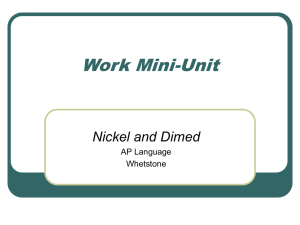Nickel and Dimed Project
advertisement
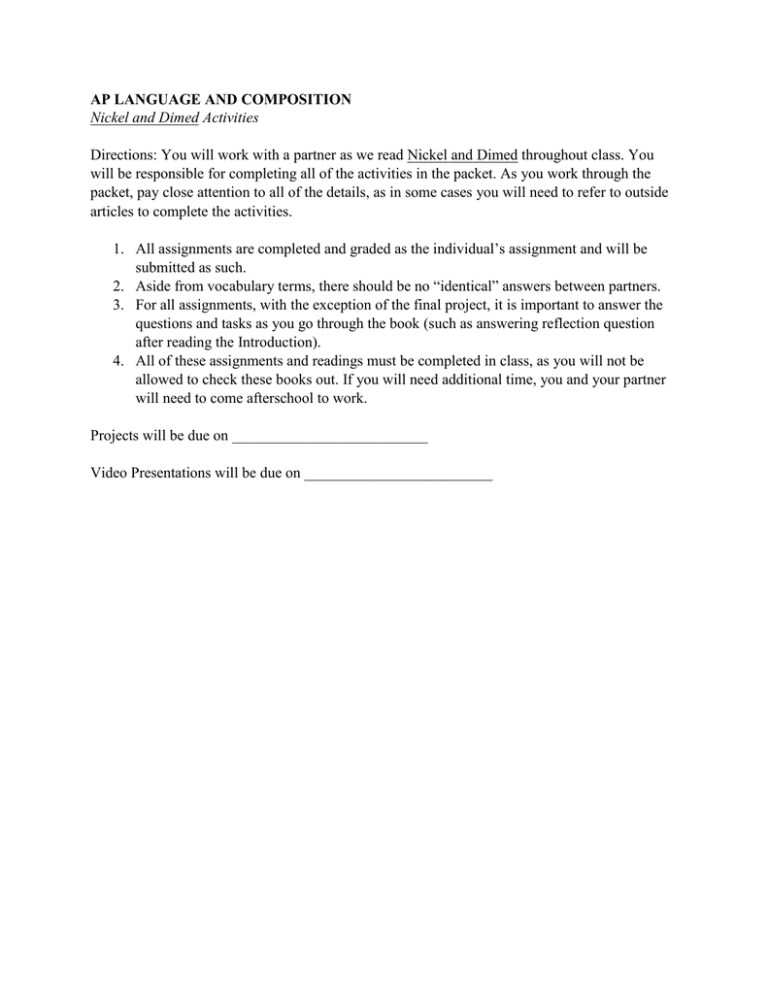
AP LANGUAGE AND COMPOSITION Nickel and Dimed Activities Directions: You will work with a partner as we read Nickel and Dimed throughout class. You will be responsible for completing all of the activities in the packet. As you work through the packet, pay close attention to all of the details, as in some cases you will need to refer to outside articles to complete the activities. 1. All assignments are completed and graded as the individual’s assignment and will be submitted as such. 2. Aside from vocabulary terms, there should be no “identical” answers between partners. 3. For all assignments, with the exception of the final project, it is important to answer the questions and tasks as you go through the book (such as answering reflection question after reading the Introduction). 4. All of these assignments and readings must be completed in class, as you will not be allowed to check these books out. If you will need additional time, you and your partner will need to come afterschool to work. Projects will be due on __________________________ Video Presentations will be due on _________________________ AP LANGUAGE AND COMPOSITION Reflections and Connection Questions Directions: For each section, answer the following questions in a minimum 3 paragraph response. Introduction (pp. 1-10) List the guidelines Ehrenreich established for herself in the experiment: what she would and what she wouldn’t do (for example, having a vehicle, but not going hungry). How realistic are these goals for people working below a minimum wage? Explain your viewpoint. What guidelines would you establish for yourself if you were to do this experiment? Why would those guidelines be important for you to observe? Chapter 1: Serving in Florida (pp. 11-49) [ANSWER 1 of the Questions] Have you had a job similar to the author’s jobs in Key West (waiting tables, housekeeping) where you’ve had problems with unreasonable bosses, like Stu and Joy? Write a brief explanation of a job you’ve had, and describe how it was similar, and how it was different from Ehrenreich’s experiences at .Hearthside and Jerry’s restaurants, and at the hotel attached to Jerry’s. What did you learn from the experience? If you haven’t had a job, discuss a stressful project or assignment you’ve had to complete in school. How did you deal with the deadlines and with the stress? Did you develop any strategies to overcome the problems in the situation? Explain. Chapter 2: Scrubbing in Maine (pp. 51-119) People often give the “right” answers that may not be the truth, as Ehrenreich did on her job application. Why should/shouldn’t people always tell the truth, both in their personal and working lives? Explain your argument, using an example (or two) from your own experience. Chapter 3: Selling in Minnesota (pp. 120-191). Describe a situation when you “turned mean” because of the stress or pressure of work or school. What was the reason, who was involved, and how did you resolve the issue? Compare this with Ehrenreich’s description of her own regression at Wal-Mart from “aggressive hospitality” to “aggressive hostility” (see p. 166 ff.) Evaluation (pp. 193-221) Ehrenreich says that employees lose their civil liberties on the job, and she expresses surprise that workers don’t exert “counter-pressure” on employers who don’t treat them decently (see p. 204 ff.). The suggestion is that workers lack knowledge of other options, and often feel alone in their struggles. What’s your experience of this? Have you ever protested working conditions, either on the job or in your academic life? Have you considered this option? What would happen if you did? Explain. AP LANGUAGE AND COMPOSITION Vocabulary in Nickel and Dimed Directions: Define each term, using the context of the novel. penury (p. 7) angstrom (p. 147) homogeneous (p. 8) apotheosis (p. 157) surfeit (p. 14) Sisyphus (p. 165) agape (p. 20) adjutant (p. 165) solipsism (p. 26) mite (p. 168) “bev” (p. 37) hortatory (p. 178) mephitic (p. 46) abasement (p. 178) entropy (p. 48) Big Box (p. 178) postprandial (p. 63) apps (p. 180) glossolalia (p. 67) “economic man” (p. 206) soteriological (p. 68) obeisance (p. 212) cineast (p. 75) “disappearing poor” (p. 216) basal (p. 78) “social contract” (p. 220) prima facie evidence (p. 78) “working poor” (p. 221) tchotchke (p. 82) penitent (p. 84) encomiums (p. 109) untouchables (p. 117) deciduous (p. 121) WIC (p. 132) pallid (p. 134) allopathic (p. 134) unctuous (p. 137) aphasic (p. 142) “time theft” (p. 146) AP LANGUAGE AND COMPOSITION Study Guide Questions 1. Near the outset, Ehrenreich (speaking of her own sister) employs the term “wage slave.” What does she mean by this? 2. What are the three rules the author sets for herself at the beginning of Nickel and Dimed? Does she ever break them? If so, when and why, in your view does she do so? 3. Early in Chapter One, Ehrenreich notes that, in terms of low-wage work, “the want ads are not a reliable measure of the actual jobs available at any particular time.” Explain why this is so. 4. Waiting tables at Jerry’s, the author meets a young dishwasher named George. Who is he? What is his story? What do he and Ehrenreich befriend one another? And why does she not “intervene” when she learns from an assistant manager that George is thought to be a thief? 5. In an extended footnote in Chapter Two, Ehrenreich explains how “the point” of the housecleaning service where she is employed “is not so much to clean as to create the appearance of having been cleaned.” Why is this? Why the deceit? What does The Maids outfit not clean its clients’ homes properly? 6. Looking back on Chapter Two as a whole, what connections would you make between maids and minorities in the United States? What about between maids and poverty, and maids and “invisibility”? Refer to the text itself when making your links. 7. Summarize the brief “story within a story” represented by the character of Caroline. Why does Ehrenreich get in touch with this person, and what does she learn from her? 8. As her stint at Wal-Mart winds down, the author mentions to several of her collegues that they “could use a union here”—only, as she herself readily admits, she is “not a union organizer anymore that [she is] Wal-Mart management material.” So why, then, is she making efforts at unionizing? What has led her to these efforts? What are her reasons, grievances, motivations and goals? 9. At the onset of her Evaluation chapter, the author seems to arrive at a new understanding of the phrase “unskilled labor.” Explain this new understanding. Do you agree with it? Why or why not? 10. Why does Ehrenreich refer to low-wage workers, at the close of her book, as “the major philanthropists of our society”? AP LANGUAGE AND COMPOSITION The American Dream-An Expose Directions: You and your partner will create a newscast exploring the ideas of poverty and the American Dream in the United States. Your newscast will include references from Barbara Ehrenreich’s expose and outside sources. Your newscast must meet the following criteria: 1. Your newscast should be a recorded and presented in a digital medium. 2. Your newscast can include a lot of creativity, but it must fit in the genre of a newscast. 3. Your newscast should be between 3-5 minutes in length. Your newscast will explore any aspect of poverty in America. It should take an objective view in understanding how people either can or can not create their own American Dream. You may take any approach to this task so long as the presentation meets formatting requirements AND has research to support your presentation. To find resources you may use any of the following resources: 1. http://www.csun.edu/afye/Teaching_Nickel_and_Dimed.html: This link includes numerous articles that are both supportive and/or highly critical to Nickel and Dimed 2. http://ehrenreich.blogs.com/barbaras_blog/: This link is to Barbara Ehrenreich’s blog in which she talks about how work (including other research texts she has written) on poverty in America. 3. http://www.colbertnation.com/the-colbert-report-videos/174872/june-23-2008/barbaraehrenreich: Interview with Stephen Colbert and Barbara Ehrenreich about the income gap between the rich and the poor. Projects will be shared on: __________________________
